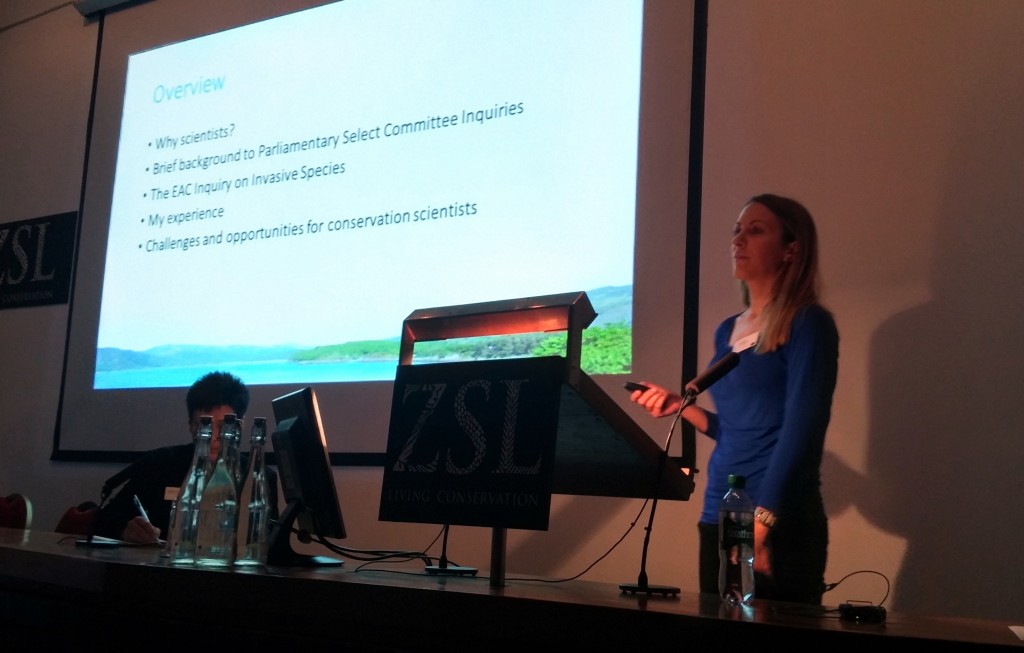Communication and complexity: making sense of the conservation science/policy interface
Should we cull badgers in the English countryside to control the spread of Bovine TB? The ongoing, fractious debate provoked by this question has in recent years provided a perfect example of the conflicts that can arise at the point where science and policy-making meet. How did we reach the point where a rock star chooses to wear a badger badge to make a political statement at the closing ceremony of the London Olympic Games?
Professor Rosie Woodroffe’s comprehensive dissection of the science and politics of the badger cull controversy provided the perfect start to last week’s symposium, jointly organised by the BES and the Zoological Society of London, on The Conservation Science Policy/Interface: Challenges and Opportunities. Acting as the launch event for the BES’s revitalised Conservation Special Interest Group, the symposium brought together over 150 scientists, conservationists and policy-makers to explore how the links between science and policy can be strengthened. As Nathalie Pettorelli, Secretary of the Conservation SIG, outlined in the lead up to the event, the relationship between science and policy is at the heart of the most topical environmental debates, from the current review of the European Birds and Habitats Directives, to the use of neonicotinoid pesticides and the future of GMOs.
Navigating complexity and uncertainty
The opening discussion of the badger cull highlighted many of the themes that cut across the day’s conversations. How do we ensure that complex, often uncertain science is communicated most effectively to policy-makers? How do science and values interact when taking decisions on contentious issues? Should scientists merely present the “facts” or become advocates for a particular course of action?

While the answers to these questions are relatively complicated, one message from the day was absolutely clear: it is crucial that scientists get involved in policy-making. As one of the speakers remarked, although “your evidence may not change the world, not getting involved won’t change anything”. There are a host of opportunities for scientists to get involved in policy: Helen Bayliss shared her experience of giving evidence to the Environmental Audit Committee, whilst Sarah Durant showed how scientists, working in collaboration with NGOs and making intelligent use of the media, had a real impact on the recently passed Infrastructure Act. Organisations including the Parliamentary Office of Science and Technology (POST), the Natural Environment Research Council and the BES all highlighted their role as conduits for scientists wishing to engage with the policy-making process.
Bridging the science-policy divide, however, is not always an easy task. It is a fallacy to assume that scientific evidence simply flows in a linear fashion into decision-making, where policies are then selected and adjusted on the basis of the latest findings. A key message from the symposium was that policy-making, like science, is a complex, uncertain and contested activity. As Professor Melanie Austen’s “horrendogram” amply illustrated, the chaotic policy landscape – in this case for marine conservation – is indicative of the sheer number of stakeholders, issues, scales and initiatives involved.
#conscipol Mel Austen. This ‘horrendogram’ shows state of UK marine policy. pic.twitter.com/d4ENqAZpuQ
— BES Conservation (@BESConservation) April 16, 2015
Scientific evidence: necessary but not sufficient
In this context, it is vital to recognise the limitations of scientific evidence in the policy-making process. Put simply, science does not have all the answers; it is often necessary for sound-decision making, but not sufficient. In dealing with complex – often “wicked” policy problems – values, judgement, and public dialogue must all be taken into account. Social science also has a vital role to play, and greater interdisciplinary working is required to enable ecologists to draw on the rich body of research as to “how policy works”, whilst also placing scientific knowledge in its wider context.
As Peter Brotherton of Natural England explained, we must respect politicians’ right to operate within the space created by scientific evidence; we should think of good policy as evidence-informed not evidence-based. The badger cull is a perfect example of how the same evidence – accompanied by disagreement between scientists – can be interpreted very differently. In situations such as this, scientists must be clear about the role they are adopting; as an “issue advocate” seeking to advance a certain policy option or an “honest broker” elucidating and clarifying the policy options.
With any interactions at the science-policy interface, good communication, married with good timing, is essential. Both Jonny Wentworth of POST and Professor Bill Sutherland, BES President, emphasised the need for scientists to be clear about uncertainty when communicating with policy-makers, while Abigail Bunker of RSPB argued that effective communication isn’t just about presenting the facts, but framing them in a way that appeal to people’s – in this case policy-makers’ – existing values. Successful interventions in the policy process, such as the “Making Space for Nature” report, work when sound science is coupled with good communication, timed and framed in the right manner.
Get involved!

Working at the interface between science and policy can be complex and challenging. Yet, as the symposium demonstrated, there are a multitude of opportunities for scientists to engage with policy-making. Scientific evidence, well communicated, has a vitally important role to play in improving the quality of environmental conservation policy. One of the BES’s ambitions for the next Parliament is that environmental policy is informed by sound scientific evidence, and that policy-makers have access to the best available ecological science to inform decision-making. If you want to help us achieve that goal, why not attend an event, try a placement, contribute to a consultation response, or apply to join our Public and Policy Committee?
Find out more about upcoming Conservation SIG events. Audio recordings and presentations from the symposium will be available online soon.
Like what we stand for?
Support our mission and help develop the next generation of ecologists by donating to the British Ecological Society.